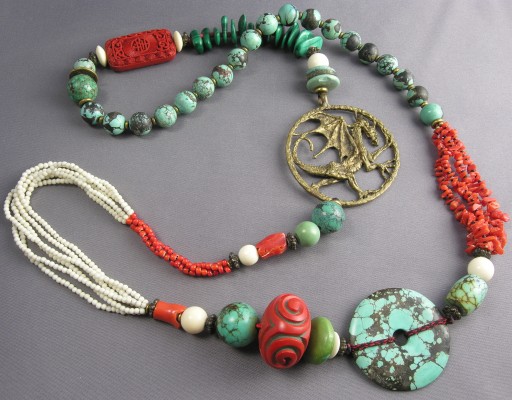I used the kumihimo technique for the first time in this necklace, to attach the chinese turquoise donut (sometimes called a pi) to the rest of the necklace, which also includes malachite, cinnabar, bone, oxblood coral, brass accents and cornaline d'aleppo (whitehearts). It varies from single to multiple strand, and the chips, as is typical for my pieces, are spaced with small (in this case 15/0) seed beads to visually separate them. The whitehearts are stitched in tubular peyote, whereas the coral strands are freefloating (they've been loosely twisted in this photograph) The dragon that serves as its focal point is cast bronze, and has both a delicacy of detail and freedom in execution I find rather rare in fantasy subjects of this type.
Rather appropriately, given the Asiatic origin of both the color scheme and the cord-making technique, I used a soldering stand as a marudai, and weighted the threads with reproductions of chinese coins, tying the threads through the square holes. Don't do it. The only other exercise rivaling that one in frustration was when I strung bugle beads on the warps of a loomed project some 5’ (150cm)long—I couldn't figure out how to wind them onto the little loom, so I let them hang down. And I use to carry the project around, so you may imagine how the warps, weighted with bugle beads, twisted and spun around each other.
Nowadays there is lots of info on kumi, including how to make jerry rigged marudais. Take advantage!

Dragon is about 34” long, with chinese turquoise, malachite, coral, cinnabar, glass, brass and bronze strung on nylon. The bronze accent piece is just over 2" in diameter, by "AC RONCARI 1987".
Text, image and objects depicted therein copyright 1998 sylvus tarn. Original photo and text—I thought perhaps at first this pic was horrid because it was taken with my very first digital camera (a kodak, which, since it had a proprietary file system that only runs on some version of windoze from a decade ago, effectively means all the images I took with it are lost) but I think it predates that; that it's almost certainly a scan of a print taken with my old film camera. Note also that the image is at the bottom of several paragraphs of text, rather than just below the initial paragraph: this was because in the days of dial-up, images loaded very slowly, and thus I supplied most of the text to give something to do while the image loaded.
UPDATE: added summary, 12jan2020. (New photo and minor updates, 01oct08.) Last modified: Sun Sep 13 17:44:49 EDT 1998
Unless otherwise noted, text, image and objects depicted therein copyright 1996--present sylvus tarn.
Sylvus Tarn